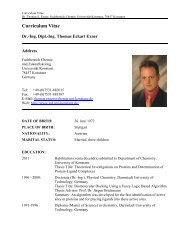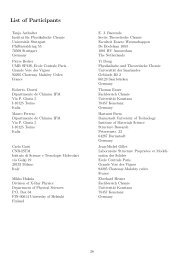Tuesday, February 6 08:45-10:15 Size Effects <strong>in</strong> Clusters Jan-Ole Joswig Physikalische Chemie und Elektrochemie, TU Dresden, 01062 Dresden Clusters are <strong>in</strong>termediates between atoms and <strong>the</strong> solid state. Usually, <strong>the</strong>y have diameters <strong>of</strong> a few ˚Angström up to several nanometers and conta<strong>in</strong>, <strong>the</strong>refore, up to several thousand atoms. In this size range, <strong>the</strong> properties <strong>of</strong> <strong>the</strong> system <strong>of</strong> <strong>in</strong>terest are affected by quantum-size effects. Thus, clusters have different properties compared to those observed <strong>in</strong> <strong>the</strong> macroscopic world. <strong>The</strong>se vary, moreover, with <strong>the</strong> cluster size. In order to ga<strong>in</strong> <strong>in</strong>sight <strong>in</strong> this size-dependence, <strong>the</strong> structural, electronic and optical properties <strong>of</strong> various metal and semiconductor clusters with up to several hundred atoms have been studied us<strong>in</strong>g different computational methods and methodological approaches. 12
Tuesday, February 6 10:45-11:45 Electron and Magnetization Density <strong>in</strong> <strong>the</strong> Transition Metal Oxide Co3V2O8 H. Fuess, N. Qureshi, H. Ehrenberg Technische Universität Darmstadt, Fachbereich Material- und Geowissenschaften, Fachgebiet Strukturforschung, Petersenstraße 23, 64287 Darmstadt, Germany E-mail: hfuess@tu-darmstadt.de Cobaltorthooxovanadate is a sp<strong>in</strong>-3/2 system on a Kagomé staircase which exhibits a sequence <strong>of</strong> five magnetic phase transitions 1 due to <strong>the</strong> relief <strong>of</strong> frustration by <strong>the</strong> decreased symmetry <strong>of</strong> <strong>the</strong> magnetic lattice (space group Cmca, Co1 on 4a and Co2 on 8e sites) 2 compared to <strong>the</strong> ideal Kagomé net. It shows a ferromagnetic ground state below 6K and an <strong>in</strong>termediate antiferromagnetic region between 6K and 11K with various commensurate and <strong>in</strong>commensurate magnetic structures. Our neutron powder diffraction experiments 3 revealed that with<strong>in</strong> <strong>the</strong> ferromagnetic phase <strong>the</strong> magnetic moments align along <strong>the</strong> a-axis with a slight cant<strong>in</strong>g along c with different values for <strong>the</strong> two different Co sites. <strong>The</strong> antiferromagnetic phase can be described by a propagation vector k=(0,ky,0) with a temperature dependent ky which changes throughout <strong>the</strong> phase. <strong>The</strong> complexity <strong>of</strong> <strong>the</strong> magnetic structures and phase transitions is be attributed to <strong>the</strong> balanc<strong>in</strong>g <strong>of</strong> <strong>the</strong> multiple Co-O-Co superexchange <strong>in</strong>teraction pathways. This complexity can be disturbed by partially substitut<strong>in</strong>g Co with Ni result<strong>in</strong>g <strong>in</strong> antiferromagnetic (CoxNi1 − x)3V2O8 compounds exhibit<strong>in</strong>g only one magnetic phase transition, which has been verified for powder samples with x=0.27, 0,52 and 0.76 4 . In order to exam<strong>in</strong>e <strong>the</strong> superexchange pathways <strong>in</strong> Co3V2O8, prelim<strong>in</strong>ary electron and magnetization density measurements have been carried out which should provide a base for <strong>the</strong>oretical <strong>in</strong>terpretation <strong>of</strong> <strong>the</strong> complicated magnetic behaviour by ref<strong>in</strong><strong>in</strong>g <strong>the</strong> obta<strong>in</strong>ed data sets us<strong>in</strong>g <strong>the</strong> multipole formalism. Hence, <strong>the</strong> anisotropy <strong>of</strong> <strong>the</strong> Co 2 + form factor, i.e. <strong>the</strong> deviation from <strong>the</strong> spherical model, should be revealed result<strong>in</strong>g <strong>in</strong> important <strong>in</strong>formation about <strong>the</strong> highly <strong>in</strong>terest<strong>in</strong>g superexchange coupl<strong>in</strong>g mechanisms. [1] Y. Chen, J.W. Lynn, Q. Huang, F.M. Woodward, T. Yildirim, G. Lawes, A.P. Ramirez, N. Rogado, R.J. Cava, A. Aharony, O. Ent<strong>in</strong>-Wohlman, A.B. Harris Phys. Rev. B 2006, 74, 014430 [2] H. Fuess, E.F. Bertaut, R. Pau<strong>the</strong>net, A. Durif Acta Cryst. 1970, B26, 2036. [3] N. Qureshi, H. Fuess, H. Ehrenberg, T.C. Hansen, D. Schwabe Sol. State Comm., submitted [4] N. Qureshi, H. Fuess, H. Ehrenberg, T.C. Hansen, C. Ritter, K. Prokes, A. Podlesnyak, D. Schwabe Phys. Rev. B 2006, 74, 212407 Acknowledgment: This research was supported by <strong>the</strong> Deutsche Forschungsgeme<strong>in</strong>schaft through <strong>the</strong> DFG 125/45 program and <strong>the</strong> Deutscher Akademischer Austausch-Dienst (DAAD). 13






